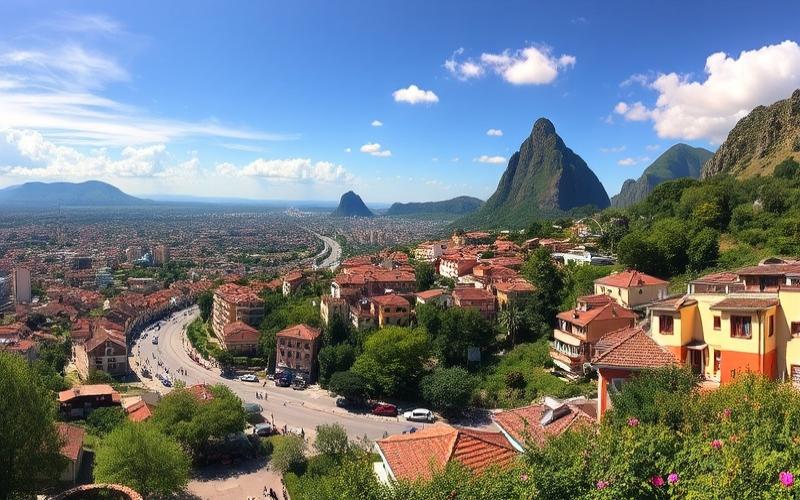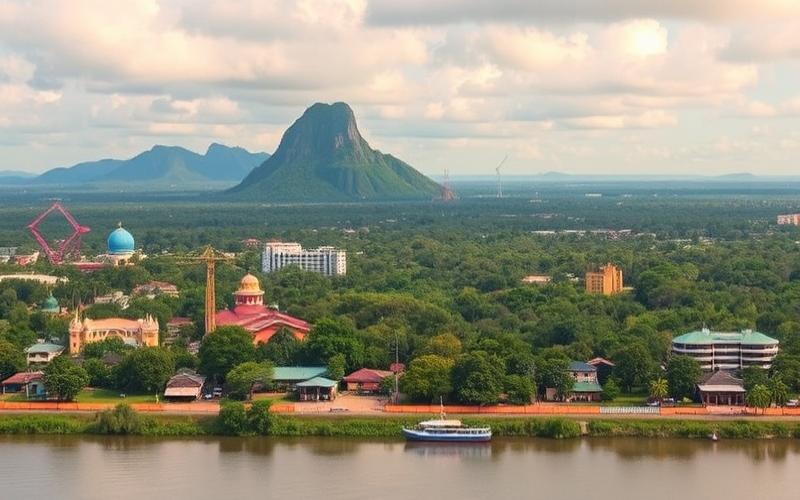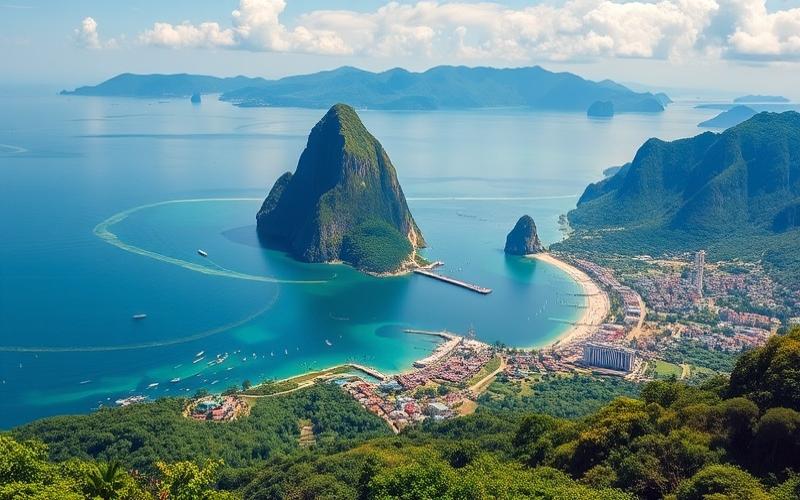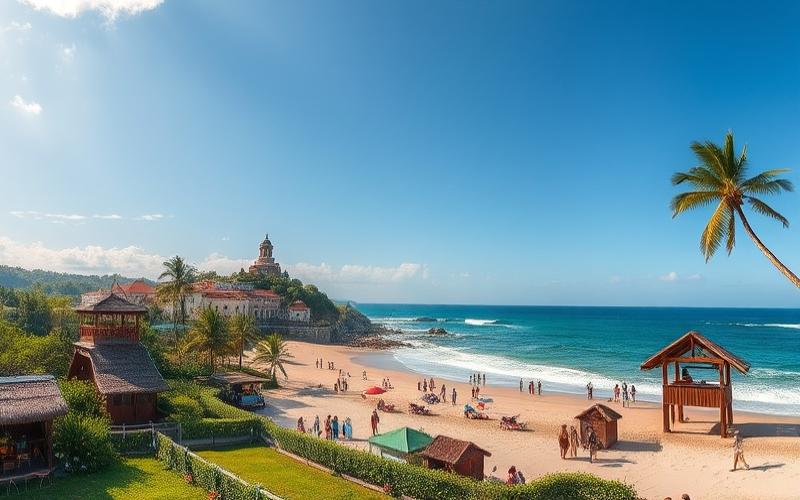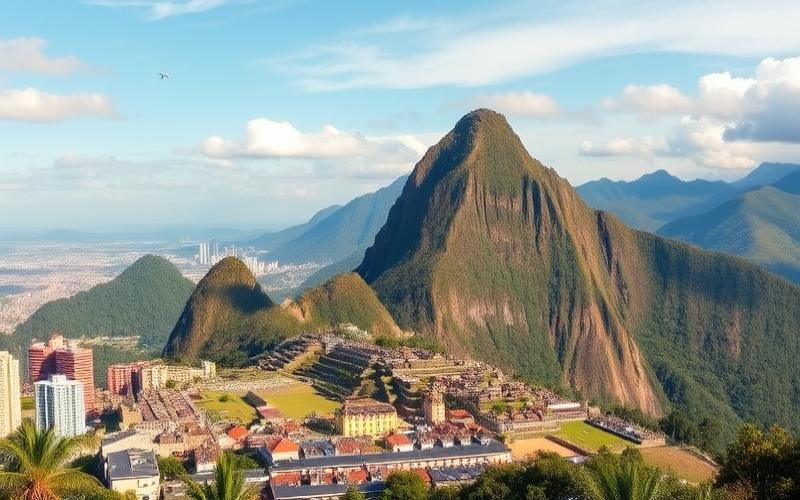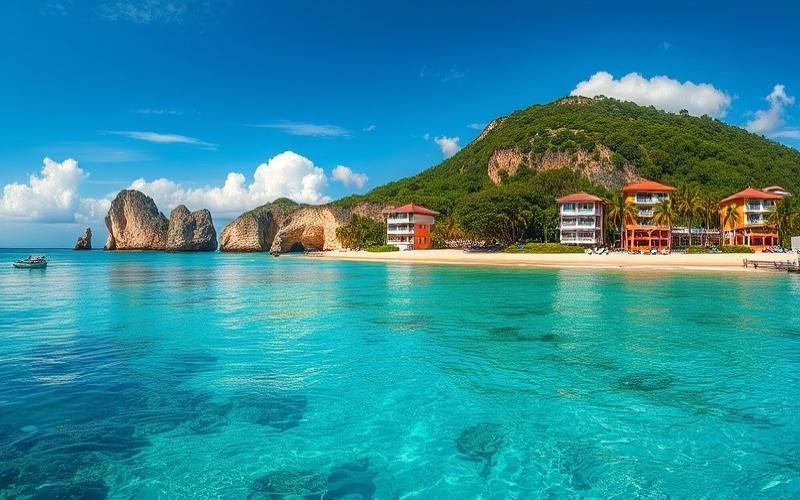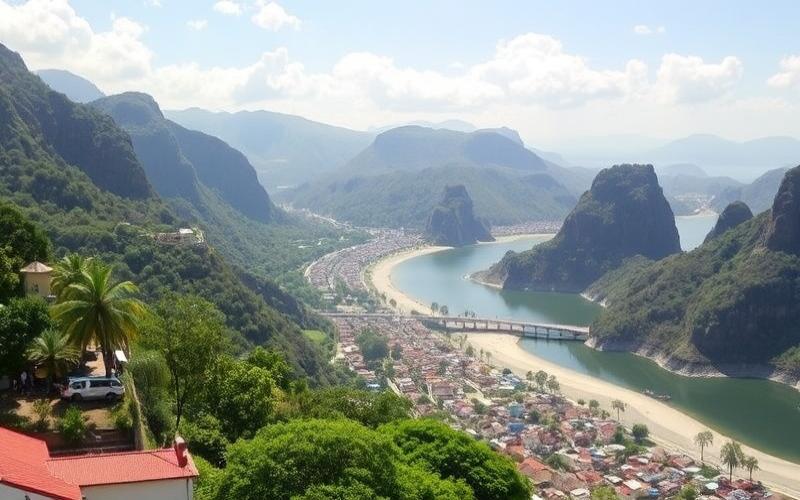
 Published on and written by Cyril Jarnias
Published on and written by Cyril Jarnias
With the Emergence of Real Estate Markets in Latin America
The choice to invest in Brazil or its neighboring countries is becoming a strategic decision for many international buyers. Brazil, with its dynamic economy and cultural diversity, offers distinct opportunities compared to other countries like Argentina, Peru, or Colombia, each with their own advantages and challenges.
Key Differences Between Real Estate Markets
This article explores the key differences in legislation, profitability, and growth potential, so you can make an informed decision based on your investment goals.
Good to Know:
Discover why the appeal of the famous Brazilian Carnival or the stunning landscapes of the Andes might influence your next real estate acquisition.
Real Estate Taxation: Brazil vs. Its Neighbors
Brazil primarily applies IPTU (annual municipal property tax, approx. 0.3% to 1.5% of the property value depending on the city), ITBI (property transfer tax upon purchase, typically 2% to 4% depending on the municipality), tax on rental income (progressive scale up to 27.5%), and capital gains tax upon resale (generally 15%), with treaties to avoid double taxation for certain foreign investors.
The framework includes indirect taxation such as sales tax/VAT ≈ 17% at the aggregate level, and withholding tax rules around 15% on certain income, useful for calibrating cross-border flows related to real estate.
Main Real Estate Taxes in Brazil
- IPTU (Property Tax): annual; approximately 0.3% to 1.5% of the property value, rates set by municipalities.
- ITBI (Transfer Tax): upon purchase; generally 2% to 4% of the property value (often 2%–3% in local practice in major cities).
- Tax on Rental Income: progressive scale 0% to 27.5% for individuals; applicable to rents received locally.
- Real Estate Capital Gains: usual rate 15% upon resale, notably for non-residents under the standard regime.
- Tax Treaties: agreements to avoid double taxation (e.g., with France) allowing for tax credit/offset.
- General tax context: aggregate sales tax/VAT around 17%; typical withholding at source of 15% on certain flows.
Comparative Table — Real Estate: Brazil vs Neighbors
| Key Element | Brazil | Argentina | Paraguay | Uruguay |
|---|---|---|---|---|
| Annual Property Tax | IPTU ~0.3%–1.5% depending on city | Data not specified here | Data not specified here | Data not specified here |
| Transfer Tax/Purchase | ITBI ~2%–4% depending on municipality | Data not specified here | Data not specified here | Data not specified here |
| Rental Income Tax (Individuals) | Progressive scale up to 27.5% | Data not specified here | Data not specified here | Data not specified here |
| Real Estate Capital Gains | ~15% (standard regime for non-residents) | Data not specified here | Data not specified here | Data not specified here |
| Advantages for Foreigners | Anti-double taxation treaties; moderate transaction costs | Data not specified here | Data not specified here | Data not specified here |
Significant Differences Highlighted
- Ownership: In Brazil, IPTU is municipal and relatively moderate (0.3%–1.5%), which predictably impacts the annual carrying cost.
- Transactions: ITBI around 2%–4% remains contained compared to other jurisdictions, contributing to moderate entry costs.
- Non-residents/Foreigners: Capital gains taxation at 15% and access to anti-double taxation treaties provide visibility and credit for taxes paid locally.
Tax Implications on Profitability (Rental Yield and IRR)
With moderate carrying costs (IPTU) and entry costs (ITBI), net profitability can remain competitive if rents cover IPTU and rental income tax; the progressivity up to 27.5% calls for optimization (deductions, structures) for high incomes.
The exit at 15% on the capital gain limits IRR erosion compared to countries applying higher levies on real estate gains, supporting after-tax performance.
Moderate transaction costs improve perceived liquidity and potential asset turnover, supporting value-add or capital recycling strategy.
Illustrative Concrete Examples
A non-resident investor acquiring an urban apartment applies a municipal ITBI of 3% and pays an annual IPTU of 1% of the assessed value; net rents are taxed according to the progressive scale, and the resale five years later triggers a 15% tax on the capital gain, with the possibility of credit via an anti-double taxation treaty if a resident of a signatory country.
A private fund targeting rental assets optimizes net yield by favoring municipalities with an IPTU close to 0.3% and integrating ITBI at 2% into its entry cost, consolidating a profitability differential compared to markets where transfer taxes are higher.
Recent Statistics and Numerical Elements
- Aggregate VAT/Sales Tax ~17% (stable 2006–2025 according to series), useful for estimating indirect charges on certain services related to real estate operation.
- Withholding at Source ~15% on certain cross-border flows, to be considered in structuring distributions and after-tax cash flow for foreign investors.
- Rental Income Tax scale up to 27.5%, ITBI 2%–4%, IPTU 0.3%–1.5%, capital gains 15%, central parameters for modeling effective real estate taxation in Brazil.
Analysis of Brazil’s Tax Prospects and Competitiveness
Brazil presents a coherent set of real estate levies with moderate transaction costs (ITBI), a municipally calibrated property tax (IPTU), and an exit tax at 15% that remains competitive for non-residents, especially when coupled with anti-double taxation treaties.
In a regional comparison, the Brazilian structure is potentially attractive, but the full assessment against Argentina, Paraguay, and Uruguay requires integrating their own tax scales and incentives for foreigners not documented here; as it stands, the predictability of Brazilian rates and contained transaction costs constitute competitive advantages.
For investors seeking stable rental income and tax visibility, focusing on municipalities with low IPTU and optimizing the income tax scale can improve net yield, while capital gains taxation at 15% supports exit performance.
Note: Detailed comparative data for Argentina, Paraguay, and Uruguay are not available in the sources mobilized here; targeted collection by country is recommended to complete the table with their equivalent IPTU rates, transfer taxes, rental taxation, and incentive regimes for non-residents.
Good to Know:
In Brazil, key real estate taxes include ITBI, a property transfer tax of 2 to 5% of the purchase price, and IPTU, the annualized property tax varying by location and property value; in contrast, Uruguay imposes a 4% transfer tax and a lower property tax. Argentina applies additional taxes that can reach 3.6% on real estate purchases, and Paraguay, while having a transfer tax of about 1%, attracts with its tax incentives for foreign investors. These differences influence profitability; for example, buyers in Uruguay often benefit from partial tax exemptions encouraging investment. According to recent studies, the real estate tax burden in Brazil appears relatively competitive, but regional economic realignments could influence this dynamic for investors seeking tax optimization.
Comparison of Real Estate Regulations in Brazil and Neighboring Countries
Brazil allows foreigners to buy and own real estate, with targeted restrictions on rural land, border areas, and certain national security zones. Acquisition requires a CPF, a contract signed before a notary, and registration in the real estate registry; the framework is structured by the Civil Code (Law 10.406/2002) and sectoral laws (leases, condominiums, subdivisions), with local decrees according to state/municipality.
Key Laws in Brazil
- Brazilian Civil Code (Law 10.406/2002): property rights and real estate contracts.
- Law 8.245/1991 (Leases): landlord-tenant rights/obligations.
- Law 4.591/1964 (Condominiums): condominium ownership and buildings under construction.
- Law 6.766/1979 (Subdivisions): urban land division.
- New Code of Civil Procedure (Law 13.105/2015): strengthens notarial/registry activity and legal security of real estate registrations.
- Law 14.711/2023 (Legal Framework for Guarantees): modernizes the use of real guarantees and aims for more effective credit, impacting real estate financing.
Acquisition Procedure in Brazil
- Obtaining a CPF (essential for foreigners).
- Due diligence: title, charges, urban compliance; preliminary contract then signing before a notary and registration in the property registry.
- Local financing possible but more complex for non-residents; many resort to financing outside Brazil.
Restrictions for Foreigners in Brazil
- Rural Land: acquisition and area limitations for foreigners/foreign legal entities.
- Border/Security Areas: specific authorizations required.
Taxes and Fees in Brazil (Cost Impact)
Municipal transfer taxes (ITBI), notary and registration fees; credit conditions may improve via Law 14.711/2023, by facilitating the mobilization of guarantees. The residential market follows a recent bullish cycle (housing index record in July 2025), affecting the total acquisition cost.
Regional Comparison: Argentina, Paraguay, Uruguay, Bolivia, Peru
Regional Similarities
Recognition of private property rights and necessity of registration in the real estate registry (legal security via land publicity). Standard procedure: title due diligence, authentic deed, registration; notary fees and transfer taxes in each country.
Major Differences (Comparative Summary)
Brazil: open framework in urban areas for foreigners; strict restrictions in rural/border areas; detailed legal structure (Civil Code, sectoral laws) and strong registry; credit facilitated by the new guarantees framework.
Argentina, Paraguay, Uruguay, Bolivia, Peru: all impose in practice a tax ID number, a notarized deed, and registration; more marked restrictions may exist in border/rural areas according to local law, and the tax cost (ITP/ITBI/ITP-like) and notary fees vary.
Taxes and Fees: Effect for Foreign Buyers
In the region, foreigners are generally aligned with the resident tax regime for transfer taxes and deed fees; the cost difference lies in the local transfer tax rate, notarial/registry fees, and currency conversion/transfer constraints. In Brazil, ITBI + deed/registry fees form the largest part of transaction costs, with local financing potentially more accessible thanks to Law 14.711/2023.
Legal/Administrative Implications for Foreign Investors
Brazil: opportunity for broad access to the urban market, strong security through registry and notarial procedures; challenges in rural/border areas and non-resident financing; necessity of a CPF and local counsel.
Neighbors: equivalent requirements for local tax ID number and notarized deed; variability of limits in border/rural areas; macro volatility (exchange rates, capital controls) potentially increasing effective transaction costs vs. Brazil where the guarantee infrastructure is modernizing.
Case Studies and Examples
Brazil (2023–2025): Law 14.711/2023 established a new guarantees framework aiming to increase collateral liquidity and improve credit supply and cost; the government expects increased market efficiency, with a spillover effect on real estate financing.
Brazil (2025): the housing index reached a record level in July 2025, signaling a dynamic market that may increase the entry price for foreign investors despite a favorable legal framework.
Synthetic Comparative Table
| Country | Foreign Access to Urban Property | Notable Restrictions | Key Requirements | Tax/Fee Particularities (Purchase) | Points of Attention |
|---|---|---|---|---|---|
| Brazil | Open in urban areas | Rural and border zones | CPF, notary, registry | ITBI, notary/registry fees; credit strengthened by Law 14.711/2023 | Registry due diligence, municipal variations |
| Argentina | Generally open (to confirm by zones) | Possible limits in border zones | Tax ID, notary, registry | Transfer tax + fees | Possible capital controls |
| Paraguay | Generally open (to confirm locally) | Possible border/rural zones | Tax ID, notary, registry | Transfer tax + fees | Titles and cadastre: increased verifications |
| Uruguay | Open, reputed legal security | Specific zones possible | Tax ID, notary, registry | Transfer tax + fees | Higher notary costs |
| Bolivia | Access with precautions | Possible border/rural zones | Tax ID, notary, registry | Transfer tax + fees | Local cadastral compliance |
| Peru | Open in urban areas | Border zone restrictions | Tax ID, notary, registry | Transfer tax + fees | Urban due diligence |
Practical Checklists for a Foreign Buyer
Brazil
- Obtain a CPF.
- Engage a specialized lawyer and a notary; verify the registry (charges, mortgages) and urban compliance.
- Anticipate restrictions in rural/border areas and authorization if necessary.
- Budget for ITBI, notary and registration fees; evaluate local financing in light of Law 14.711/2023.
Neighboring Countries
- Obtain a local tax ID number; use a notary and verify the land registry.
- Check limitations in border/rural zones and authorization requirements.
- Calculate transfer taxes and deed/registry fees; account for exchange rules and international transfers.
Good to Know:
In Brazil, real estate purchase is governed by the 1964 Real Estate Law, with a rigorous registration procedure and some restrictions for foreigners, particularly in rural or border areas, while taxes like ITBI apply fees up to 3% of the purchase price. In comparison, Argentina imposes similar taxes with fewer restrictions for foreigners, although their registration processes are slightly more bureaucratic, while Paraguay offers more flexible regulation and reduced fees, thus attracting more foreign investors. In Uruguay, laws are transparent and encourage foreign investment, although acquisition costs include real estate taxes and notary fees. Bolivia, on the other hand, has more restrictive laws on foreign ownership, sometimes causing difficulties in international transactions. Peru stands out with legislation favorable to international investors, but with taxes that can reach 5%, depending on the property’s location. Investors must consider these variables before acquiring property, as significant differences in fees and administrative constraints can influence profitability and real estate expansion possibilities, as shown by recent studies from the University of São Paulo on the impacts of taxes and restrictions on international investments in South America.
Investing in Brazil: Advantages and Challenges Compared to Neighboring Countries
Brazil attracts real estate investors thanks to a mix of targeted tax incentives, investment residency options, and a deep and diversified market, although tax complexity, bureaucracy, and real volatility constitute notable challenges.
Key Tax and Regulatory Incentives in Brazil
- Rental Income: IRPF scale up to 27.5% with a standard 20% deduction on gross rents, plus a wider range of deductions (maintenance, IPTU, management, loan interest).
- Specific Regimes: “flat service” regime for short-term rentals with a flat tax of 5% on revenue, attractive for Airbnb-type rentals.
- Non-residents: rental tax generally 15–25%, capital gain 15% upon resale; ITBI 2–4% upon acquisition, variable annual IPTU depending on the municipality.
- Treaty Network: double taxation avoidance agreements with over 30 countries, reducing international tax burden.
- Investor-Residency Aspect: residency permit through real estate investment (Normative Resolution No. 36/2018), facilitating the settlement of foreign investors meeting amount and fund origin criteria.
Regional Comparison of Incentives (Brazil vs Argentina, Colombia, Chile)
- Brazil
- Strengths: substantial deductions, 5% short-term regime, numerous DTTs, real estate-linked residency option.
- Weaknesses: multiplicity of taxes (federal/state/municipal), local variability (ITBI/IPTU), non-resident rates to monitor.
- Argentina
- Regional general trends to compare: real estate taxation often burdened during macro adjustment periods; capital controls likely to affect exit/repatriation.
- Note: Brazil stands out for its investment residency mechanism and 5% short-stay regime, not generalized at the regional level.
- Colombia
- Regional general trends to compare: rental and capital gains taxation exist, with frequent reforms.
- Note: the depth of the Brazilian market and the range of deductions/allowances create an attractiveness differential compared to simpler but less generous frameworks.
- Chile
- Regional general trends to compare: regulatory environment often more stable, but specific rental incentives less marked than Brazil’s 5% regime for short stays.
- Note: Brazil offers more incentive pathways combining taxation, international treaties, and residency.
Local Brazilian Real Estate Market Trends
- Broad, urban, and tourist market, where short-term rentals benefit from dedicated tax treatment, supporting net profitability in tourist and business hubs.
- Transaction costs (ITBI) and recurring charges (IPTU) vary widely by city, influencing investment location.
- Market access facilitated by investor-residency, likely to increase foreign demand in specific segments.
Economic, Social, and Political Factors Influencing the Investment Climate in Brazil
- Macro stability and inflation: incentive structure (allowances, 5% regime) partially mitigates gross yield erosion, but taxation remains progressive and the currency volatile, requiring hedging strategies.
- Infrastructure: appeal of cities with competitive IPTU/ITBI and good urban infrastructure is key, due to municipal fiscal decentralization.
- Political and administrative framework: existence of investment residency reflects a pro-capital orientation; however, procedures and proof of fund origin are strict.
Specific Challenges in Brazil and Regional Comparison
Bureaucracy and Tax Complexity
- Brazil: overlay of taxes and local rules, requiring optimization and tax advice; residency procedures demanding documentary compliance.
- Region: Argentina and Colombia also present regulatory layers and frequent reforms; Chile is often perceived as more predictable, but with fewer targeted incentives than Brazil’s 5% regime.
Zoning and Local Policies
- Brazil: municipal disparities on IPTU/ITBI and short-term rental regulations condition yields.
- Region: neighboring urban environments also impose zoning rules; Brazil’s advantage remains the possibility to exploit the “flat service” tax regime where authorized.
Currency Fluctuations and Repatriation
- Brazil: real volatility can amplify cycles; presence of DTTs and non-resident status clarify withholdings and capital gains.
- Region: Argentina is exposed to capital controls; Colombia and Chile have freer frameworks but without Brazil’s combined set of incentives.
Synthetic Comparative Table
| Country | Key Tax Incentives | Residency via Real Estate Investment | Local Tax Complexity | Main Points of Attention |
|---|---|---|---|---|
| Brazil | 20% rental allowance, broad deductions, 5% short-term regime, DTTs | Yes (RN No.36/2018) | High (variable ITBI/IPTU) | Bureaucracy, BRL volatility, local rental rules |
| Argentina | More limited incentives and subject to cycles | Not presented here | Variable | Capital controls, predictability |
| Colombia | General incentives, frequent reforms | Not presented here | Medium | Tax stability, reform evolution |
| Chile | Regulatory stability, fewer targeted incentives | Not presented here | Medium-low | Fewer dedicated tax benefits |
Recommendations for Potential Investors
- Brazil
- Target cities where ITBI/IPTU are competitive and where short-term rental is viable to benefit from the 5% regime and 20% allowance on gross rents.
- Structure the investment according to DTTs and non-resident status to optimize withholdings and capital gains; plan for currency hedging.
- Use investment residency to secure local presence and asset management, anticipating documentary requirements of RN No.36/2018.
- Argentina
- Prioritize flexible exit strategies and convertibility risk management; compare total tax cost with Brazil’s more incentive framework.
- Colombia
- Monitor tax reforms; arbitrate between simplicity and net yield, knowing that Brazil offers more targeted optimization levers.
- Chile
- Value regulatory predictability; accept a narrower range of incentives than Brazil, in exchange for increased stability.
Brazil combines concrete tax advantages (allowance, deductions, 5% short-term), a treaty network, and an investor-residency pathway, at the cost of higher administrative complexity and exchange risk; its neighbors generally offer more simplicity or stability, but fewer optimization levers and access.
Good to Know:
Investing in Brazil presents distinct advantages and challenges compared to Argentina, Colombia, and Chile. Brazil offers attractive tax incentives and a dynamic real estate market thanks to a recent drop in interest rates, unlike Argentina which struggles with galloping inflation. However, Brazilian bureaucracy and strict zoning policies can complicate tasks for investors. In Colombia, despite favorable taxation, political instability represents a risk, while in Chile, economic stability is an asset, although costs are often higher. The weakness of the Brazilian currency against the dollar offers advantageous buying opportunities but increases the risk of fluctuations. To navigate these varied environments, investors should carefully analyze local infrastructure and diversify their portfolios to mitigate risks.
Real Estate Market Trends: Brazil vs Neighboring Countries
Brazil in 2023 displayed a resilient real estate market with moderate residential growth and a robust recovery in logistics/commercial segments, while its neighbors experienced more heterogeneous trajectories, often constrained by inflation, credit costs, and political stability.
- In Brazil, the residential market size is estimated at 56.56 billion USD in 2023, with a projection of 59.61 billion USD in 2024 and a CAGR of approximately 5.4% until 2029.
- Commercial real estate is expected to reach 63.67 billion USD in 2024 and grow at a CAGR of 8.7% towards 96.62 billion USD, driven by logistics/industrial and added supply in the Southeast (Minas Gerais, São Paulo).
- Buyer preferences shifted towards better-equipped properties and home office spaces, with notable dynamism in the high-end segment in Rio, against a backdrop of a depreciated real stimulating foreign investment.
List of Highlights by Country
- Brazil
- Residential: 56.56 billion USD (2023); projection 59.61 billion USD (2024); CAGR ~5.4% until 2029.
- Commercial/logistics: addition of 622,501 m² Q4-2022; net absorption 351,050 m²; vacancy 10.85% in Q4-2022; growth trajectory 2024-2029 at 8.7% CAGR.
- Demand: sustained in logistics and modern/flexible offices in major metropolises; dynamic luxury segment in Rio, fueled by local and foreign buyers.
- Policies: support for affordable housing and dedicated programs stimulate the accessible segment, with a structural housing deficit.
- Prices/trends: stabilization in major cities, moderate growth in secondary cities and tourist areas; preference for outdoor spaces and home technologies.
- Argentina
- Demand and prices: market constrained by high inflation and limited credit access, dollarization of transactions and lengthened stocks (inferences based on regional dynamics, to interpret cautiously).
- Policies: capital controls and political uncertainties affecting investment (inference).
- Commercial: partial resilience of prime segments, but vacancy and lease renegotiations more frequent (inference).
- Uruguay
- Demand: relative macro stability and influx of foreign buyers (notably Argentinians) supporting Montevideo and coastal areas (inference).
- Prices: premium on prime assets and coastal residential; rental market attractive for investors (inference).
- Policies: stable legal framework, taxation perceived as predictable (inference).
- Paraguay
- Demand: urban growth (Asunción) and logistics developments, supported by lower land costs (inference).
- Prices: progression from low bases; competitive rental yields (inference).
- Policies: investment incentives, procedure simplification (inference).
- Bolivia
- Demand: narrower market, dependent on domestic income; residential development in La Paz/Santa Cruz (inference).
- Prices: moderate growth, sensitivity to economic conditions and credit (inference).
- Policies: significant public role in financing/social housing (inference).
Comparative Table 2023 (Residential and Commercial)
| Country | Residential Market Size 2023 | Residential Price Dynamics | Commercial/Logistics | Key Policies |
| Brazil | 56.56 billion USD | Stabilization in major cities; moderate rise in secondary cities and tourist zones | Logistics supply additions; vacancy ~10.9% end 2022; CAGR 8.7% (2024-2029) | Affordable housing programs; logistics support |
| Argentina | n/a | Inflation/credit pressure; dollarization; heterogeneity (inference) | Offices/retail under pressure; prime segments more resilient (inference) | Capital controls; political uncertainty (inference) |
| Uruguay | n/a | Stability, coastal premium; foreign demand (inference) | Logistics/industrial in moderate growth (inference) | Stable framework, attractive for capital (inference) |
| Paraguay | n/a | Growth from low base; high yields (inference) | Nascent logistics/industrial development (inference) | Investment incentives (inference) |
| Bolivia | n/a | Moderate; credit-dependent (inference) | Limited market; targeted projects (inference) | Public role in housing (inference) |
Explanatory Factors for the Gaps
- Economic
- Brazil: market depth, broad industrial/logistics base; gradually decreasing financing costs supporting demand, despite logistics vacancy rising to 10.85% end 2022.
- Neighbors: inflation and dollarization (Argentina), reduced market size (Paraguay, Bolivia), stability premium (Uruguay) influence absorption, pricing, and financing (inferences).
- Policy and Regulatory
- Brazil: housing programs and support for affordable segments; logistics pipeline sustained by e-commerce/industry demand.
- Neighbors: capital controls in Argentina; pro-investment environment in Uruguay; targeted incentives in Paraguay; public intervention in Bolivia (inferences).
- Social
- Post-pandemic reallocation towards larger and outdoor spaces, partial telework stimulants for quality residences and flexible offices in Brazil.
- Cross-border buyer flows (Argentina to Uruguay) modify local demand (inference).
Concrete Examples and Statistics
- Brazil
- Residential market size: 56.56 billion USD (2023); projection 59.61 billion USD (2024); CAGR ~5.4% until 2029.
- Commercial/logistics: +622,501 m² delivered Q4-2022; 351,050 m² net absorption; vacancy 10.85% end 2022; commercial market 63.67 billion USD (2024), towards 96.62 billion USD medium-term.
- Luxury segment: 200% increase over 5 years in Rio (high-end market), demand for outdoor spaces and telework functions, foreign investor interest favored by real depreciation.
- Neighbors
- Uruguay: increase in foreign residential purchases on the coast and in Montevideo (inference).
- Argentina: reduced volumes and high stocks in residential due to inflation/credit (inference).
- Paraguay: warehouse/office pipeline in Asunción, high yields (inference).
- Bolivia: targeted residential projects in Santa Cruz/La Paz, credit-dependent (inference).
2024–2026 Outlook (Short-Medium Term)
- Brazil
- Residential: continuation of moderate growth with support from housing programs; persistent regional price dispersion.
- Commercial: logistics and industrial drivers, gradual vacancy reduction if demand remains sustained; aggregate growth close to the projected 8.7% CAGR.
- Offices: demand for flexible formats and prime quality in São Paulo/Rio, while obsolete stocks suffer higher vacancy (inference).
- Neighboring Countries
- Argentina: recovery conditioned on disinflation and easing of controls; catch-up potential if credit normalizes (inference).
- Uruguay: stable trajectory, supported by foreign capital; continued upward pressure on prime assets (inference).
- Paraguay: growth of new logistics/residential from a low base; maintained attractive yields (inference).
- Bolivia: gradual progression, focused on urban residential; dependence on domestic financing (inference).
Points of Vigilance
- Financing costs and regional inflation trajectories (high sensitivity outside Brazil).
- Logistics vacancy in Brazil to monitor despite demand: 10.85% end 2022 after quarterly increase.
- Political/regulatory risks, notably capital controls (Argentina) and stability of incentives (Paraguay) (inferences).
Verified Key Information
- Brazilian residential market 2023–2024 and CAGR: confirmed.
- Brazilian commercial/logistics dynamics, delivery/absorption/vacancy metrics and projected growth: confirmed.
- Luxury trends and post-Covid preferences in Rio, role of depreciated real: confirmed.
Good to Know:
In 2023, the Brazilian real estate market experienced rising prices, particularly in major cities like São Paulo and Rio de Janeiro, due to strong demand and a favorable economic environment, marked by GDP growth and low interest rate policies. In contrast, Argentina faces economic and political instability that puts pressure on its real estate market, characterized by stagnant prices despite increased demand for luxury properties. Paraguay and Bolivia benefit from a more moderate market dynamic, with stable growth influenced by public infrastructure investments and facilitated access to mortgage credit. In Uruguay, political stability and tax incentives attract foreign investors, stimulating demand in tourist areas like Punta del Este. The marked differences between these countries are explained by variations in economic and fiscal policies as well as social factors, such as unemployment rates and urbanization, with promising prospects for Brazil and Uruguay, where strong medium-term demand is anticipated.
Disclaimer: The information provided on this website is for informational purposes only and does not constitute financial, legal, or professional advice. We encourage you to consult qualified experts before making any investment, real estate, or expatriation decisions. Although we strive to maintain up-to-date and accurate information, we do not guarantee the completeness, accuracy, or timeliness of the proposed content. As investment and expatriation involve risks, we disclaim any liability for potential losses or damages arising from the use of this site. Your use of this site confirms your acceptance of these terms and your understanding of the associated risks.


